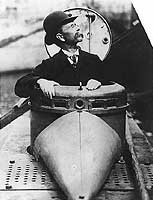
John Philip Holland was born in County Clare, Ireland, on 24 February 1841. Following a decade and a half as an educator, he moved to the United States in the early 1870s. Years before, Holland had developed a strong interest in the potential of submarines in warfare, and pursued this actively while working as a teacher in Paterson, New Jersey. During the mid-1870s he combined his submarine work with an equally strong passion for the cause of Irish independence. Sponsored by an Irish revolutionary group, the Fenian Brotherhood, he built the small one-man submarine Holland I and, later, a larger undersea craft that was known as the Fenian Ram. Though both were qualified successes, in 1883 the Fenians seized the Fenian Ram and turned their efforts in other directions. In the next few years Holland built two more submarines, one in partnership with the inventor of the pneumatic dynamite gun, U.S. Army officer Edmund L. Zalinski.
However, though solving many of the practical problems involved in underwater operation, Holland had continual difficulties in obtaining the money necessary to keep his work going, and lived in the constant hope that the U.S. Navy would provide support. Beginning in the later 1880s a long and frustrating process finally, in 1895, generated a Navy contract for the boat that became the first Plunger, which was launched in 1897. However, unrealistic requirements led Holland to abandon any hope that this complex craft would ever be satisfactory, and he almost simulanteously began work on another submarine, entirely of his own devising. Also launched in 1897 and christened Holland (or Holland VI), this boat met the expectations of its designer, and of the Navy, which purchased it in April 1900.
His financial needs had forced Holland to join forces with Isaac Rice, whose other business interests included electric storage batteries and electrically powered small craft, both relevant to the submarine field. His own J.P. Holland Torpedo Boat Company became a subsidiary of Rice's newly formed Electric Boat Company. Though largely responsible for the designs of the next ten U.S. Navy submarines (from Plunger through Tarantula) Holland's own concepts of submarine requirements diverged significantly from those of the Navy, and his relationship with the Electric Boat Company ended in 1904. Though he remained active in the undersea vessel field, John P. Holland could not gain the financing necessary to construct any more submarines. He died at Newark, New Jersey, on 12 August 1914, at the beginning of the great World conflict that would convincingly demonstrate the military effectiveness of the weapon he had done so much to create.
The submarine Holland (Submarine Torpedo Boat # 1), 1900-1913, and submarine tenders Holland (AS-3), 1926-1953, and Holland (AS-32), 1963-____, were named in honor of John P. Holland.
This page features all the views we have of submarine pioneer John P. Holland.
| If you want higher resolution reproductions than the "Online Library's" digital images, see: "How to Obtain Photographic Reproductions." |
Click on the small photograph to prompt a larger view of the same image.
| If you want higher resolution reproductions than the "Online Library's" digital images, see: "How to Obtain Photographic Reproductions." |
Page made 10 June 2004